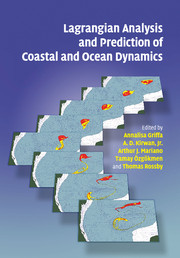Book contents
- Frontmatter
- Contents
- List of contributors
- Preface
- 1 Evolution of Lagrangian methods in oceanography
- 2 Measuring surface currents with Surface Velocity Program drifters: the instrument, its data, and some recent results
- 3 Favorite trajectories
- 4 Particle motion in a sea of eddies
- 5 Inertial particle dynamics on the rotating Earth
- 6 Predictability of Lagrangian motion in the upper ocean
- 7 Lagrangian data assimilation in ocean general circulation models
- 8 Dynamic consistency and Lagrangian data in oceanography: mapping, assimilation, and optimization schemes
- 9 Observing turbulence regimes and Lagrangian dispersal properties in the oceans
- 10 Lagrangian biophysical dynamics
- 11 Plankton: Lagrangian inhabitants of the sea
- 12 A Lagrangian stochastic model for the dynamics of a stage structured population. Application to a copepod population
- 13 Lagrangian analysis and prediction of coastal and ocean dynamics (LAPCOD)
- Index
- Plate section
- References
10 - Lagrangian biophysical dynamics
Published online by Cambridge University Press: 07 September 2009
- Frontmatter
- Contents
- List of contributors
- Preface
- 1 Evolution of Lagrangian methods in oceanography
- 2 Measuring surface currents with Surface Velocity Program drifters: the instrument, its data, and some recent results
- 3 Favorite trajectories
- 4 Particle motion in a sea of eddies
- 5 Inertial particle dynamics on the rotating Earth
- 6 Predictability of Lagrangian motion in the upper ocean
- 7 Lagrangian data assimilation in ocean general circulation models
- 8 Dynamic consistency and Lagrangian data in oceanography: mapping, assimilation, and optimization schemes
- 9 Observing turbulence regimes and Lagrangian dispersal properties in the oceans
- 10 Lagrangian biophysical dynamics
- 11 Plankton: Lagrangian inhabitants of the sea
- 12 A Lagrangian stochastic model for the dynamics of a stage structured population. Application to a copepod population
- 13 Lagrangian analysis and prediction of coastal and ocean dynamics (LAPCOD)
- Index
- Plate section
- References
Summary
The use of a particle-following or Lagrangian perspective to follow the dynamics of life in the sea is explored from a variety of perspectives. The discussion begins with the consideration of the energetics of marine organisms and a demonstration that mean field models fail to adequately describe the life of large marine fishes in the sense that they require sizable, > 100–1000 X aggregation of prey over the average biomass density in the ocean. In place of a mean field model in time a structured population model where populations are dependent on space, time, age, and their metabolism is derived. Having introduced the structured model it is then argued that it is impractical to use such a model except in a Lagrangian frame. Methods for coupling these models in a Lagrangian description of the marine environment are then discussed. This section of the manuscript ends with an appraisal of the amount of spatial aggregation required to support large pelagic fishes such as swordfish and tunas. The second portion of the paper goes on to provide examples of trajectories in different marine environments including boundary currents, mesoscale eddy fields and fronts, and the coastal environment. An emphasis on the dynamics of trajectories at various trophic levels provides insights on aggregation mechanisms and rates.
The last two sections introduce methods of modeling population structure with Lagrangian trajectories.
- Type
- Chapter
- Information
- Lagrangian Analysis and Prediction of Coastal and Ocean Dynamics , pp. 275 - 348Publisher: Cambridge University PressPrint publication year: 2007
References
- 1
- Cited by



